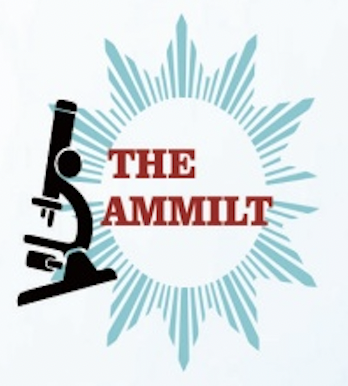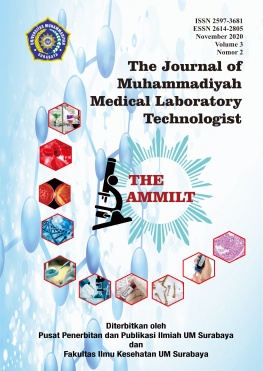Isi Artikel Utama
Abstrak
The IUD is the primary choice in the recommended long-term use of contraception. IUDs are widely used by women of childbearing age 20-35 years and have bleeding complications. This bleeding can cause a decrease in haemoglobin levels, so it is at risk of causing anemia. This research is analytical research with a cross-sectional design. This study aimed to determine the relationship between the duration of the IUD use and haemoglobin levels in family planning acceptors in the Tanah Kedinding Surabaya Health Center work area in 2020 with a sample of 11 IUD acceptors. Based on the results of the study, it was found that from the 11 respondents studied, 8 respondents (72.72%) were women of childbearing age users of long-term use IUDs, there were 5 people (62.50%) were anemic and as many as 3 respondents (27.27%) who were not anemic. Meanwhile, of the 3 (27.27%) women with IUDs using short-term IUDs, one respondent (33.33%) was anemic, and two respondents (66.7%) were not anemic. The Chi-Square test analysis results show that the calculated X2 value > X2 table is 7.236 > 3.841. This study concludes that there is a relationship between the duration of IUD use and Hb levels in IUD acceptors in the Tanah Kalikedinding Health Center work area in 2020. It is expected that health workers will check Hb levels at the start of IUD insertion and during acceptors' return visits and give Fe tablets to acceptors Kb long-term IUD
Keywords        : duration, IUD use, haemoglobin level
Rincian Artikel
Referensi
- Adeyemi-Fowode, O. A., & Bercaw-Pratt, J. L. (2019). Intrauterine devices: effective contraception with noncontraceptive benefits for adolescents. Journal of Pediatric and Adolescent Gynecology, 32(5), S2–S6.
- Amalia, F., Masyitoh, S. U., & Erniati, E. (2013). Alat Kontrasepsi Dalam Rahim Sebagai Salah Satu Faktor Resiko Anemia Defisiensi Besi. Indonesian Journal of Reproductive Health, 4(1), 23–29.
- Asrina, A., Suhartatik, S., & Ferial, E. W. (2014). Faktor-faktor yang berhubungan dengan kejadian anemia pada ibu hamil di rumah sakit ibu dan anak siti fatimah makassar. Jurnal Ilmiah Kesehatan Diagnosis, 4(1), 70–79.
- Birliani. (2019). Gambaran Faktor-faktor yang Mempengaruhi Pemilihan Alat Kontrasepsi Intra Uterin Device (IUD) di Puskesmas Jetis Kota Yogyakarta . Universitas’ Aisyiyah Yogyakarta.
- Dewi, & Khusniyati. (2017). Hubungan Lama Penggunaan Kontrasepsi IUD Dengan Kejadian Anemia Pada Peserta Kontrasepsi IUD Di Desa Gayaman Kecamatan Mojoanyar Kabupaten Mojokerto .
- Dwi, E., Yudianti, I., & Widarin, I. E. (2017). Kadar Hemoglobin Pada Akseptor KB IUD. MIKIA: Mimbar Ilmiah Kesehatan Ibu Dan Anak (Maternal and Neonatal Health Journal), 56–62.
- Estrin, D. J. (2000). Egyptian women who use an IUD have a higher risk of anemia than those who rely on other methods. International Perspectives on Sexual and Reproductive Health, 26(3), 142.
- Friedman, J., & Oluronbi, R. A. (2019). Types of IUDs and mechanism of action. In Optimizing IUD Delivery for Adolescents and Young Adults (pp. 29–39). Springer.
- Han, L., Taub, R., & Jensen, J. T. (2017). Cervical mucus and contraception: what we know and what we don’t. Contraception, 96(5), 310–321.
- Herawati, N. (2015). Mengenal Anemnia dan Peranan Erythropoietin. Biotrends, 4(1), 35–39.
- Jamil. (2016). Gambaran Pola Menstruasi Pada Akseptor IUD Di Puskesmas Banguntapan I Kabupaten Bantul Yogyakarta.
- Kurniati, I. (2020). Anemia defisiensi zat besi (Fe). Jurnal Kedokteran Universitas Lampung, 4(1), 18–33.
- Low, M. S. Y., Speedy, J., Styles, C. E., Deâ€Regil, L. M., & Pasricha, S. (2016). Daily iron supplementation for improving anaemia, iron status and health in menstruating women. Cochrane Database of Systematic Reviews, 4.
- Madden, T. (2018). Intrauterine contraception: Background and device types. UpToDate. Waltham, MA: UpToDate.
- Manuaba, I. A. C. (2009). Buku Ajar Patologi Obstetri.
- Matahari, R., Utami. Fitriana Putri, & Sugiharti, S. (2019). Buku Ajar Keluarga Berencana dan Kontrasepsi (R. Sofianingsih, Ed.). Penerbit Pustaka Ilmu.
- Mawarni, Dharminto, & Efendi. (2015). Hubungan Beberapa Keluhan Pus dengan Lama Pemakaian IUD pada Akseptor Aktif IUD di Kecamatan Mijen Kota Semarang Tahun 2013. Jurnal Kesehatan Masyarakat Universitas Diponegoro, 3(1).
- Mayan Mayura, & I Gusti Putu. (2014). Risk Of Iron Deviciency Anemia And Cervical Lesions In Intrauterine Device Type CuT 380 A Application. E-Journal of Obstetric and Gynecology Udayana, 2(5).
- Prijatni, I., Prijatni, I., & Rahayu, S. (2016). Kesehatan reproduksi dan keluarga berencana. Pusdik SDM Kesehatan.
- Revinovita, R. (2020). Hubungan Lama Penggunaan Intrauterine Device Dengan Kadar Hemoglobin Pada Akseptor Kb Iud Di Wilayah Kerja Puskesmas Bangko Tahun 2020. Dinamika Kesehatan : Jurnal Kebidanan Dan Keperawatan, 11(1), 264–271.
- Tarigan, S. (2019). Analisa Kadar Hemoglobin Darah dengan Metode Stick pada Calon Donor di Unit Transfusi Darah Rumah Sakit Umum Daerah Dr. Pirngadi Medan.
- Vahter, M., Berglund, M., Åkesson, A., & Liden, C. (2002). Metals and women’s health. Environmental Research, 88(3), 145–155.
- Widyaningtyas, R. N., Wahyuningsih, H. P., & Estiwidani, D. (2015). Hubungan umur dan lama penggunaan IUD dengan efek samping penggunaan IUD. Jurnal Kesehatan Ibu Dan Anak, 8(2).
Referensi
Adeyemi-Fowode, O. A., & Bercaw-Pratt, J. L. (2019). Intrauterine devices: effective contraception with noncontraceptive benefits for adolescents. Journal of Pediatric and Adolescent Gynecology, 32(5), S2–S6.
Amalia, F., Masyitoh, S. U., & Erniati, E. (2013). Alat Kontrasepsi Dalam Rahim Sebagai Salah Satu Faktor Resiko Anemia Defisiensi Besi. Indonesian Journal of Reproductive Health, 4(1), 23–29.
Asrina, A., Suhartatik, S., & Ferial, E. W. (2014). Faktor-faktor yang berhubungan dengan kejadian anemia pada ibu hamil di rumah sakit ibu dan anak siti fatimah makassar. Jurnal Ilmiah Kesehatan Diagnosis, 4(1), 70–79.
Birliani. (2019). Gambaran Faktor-faktor yang Mempengaruhi Pemilihan Alat Kontrasepsi Intra Uterin Device (IUD) di Puskesmas Jetis Kota Yogyakarta . Universitas’ Aisyiyah Yogyakarta.
Dewi, & Khusniyati. (2017). Hubungan Lama Penggunaan Kontrasepsi IUD Dengan Kejadian Anemia Pada Peserta Kontrasepsi IUD Di Desa Gayaman Kecamatan Mojoanyar Kabupaten Mojokerto .
Dwi, E., Yudianti, I., & Widarin, I. E. (2017). Kadar Hemoglobin Pada Akseptor KB IUD. MIKIA: Mimbar Ilmiah Kesehatan Ibu Dan Anak (Maternal and Neonatal Health Journal), 56–62.
Estrin, D. J. (2000). Egyptian women who use an IUD have a higher risk of anemia than those who rely on other methods. International Perspectives on Sexual and Reproductive Health, 26(3), 142.
Friedman, J., & Oluronbi, R. A. (2019). Types of IUDs and mechanism of action. In Optimizing IUD Delivery for Adolescents and Young Adults (pp. 29–39). Springer.
Han, L., Taub, R., & Jensen, J. T. (2017). Cervical mucus and contraception: what we know and what we don’t. Contraception, 96(5), 310–321.
Herawati, N. (2015). Mengenal Anemnia dan Peranan Erythropoietin. Biotrends, 4(1), 35–39.
Jamil. (2016). Gambaran Pola Menstruasi Pada Akseptor IUD Di Puskesmas Banguntapan I Kabupaten Bantul Yogyakarta.
Kurniati, I. (2020). Anemia defisiensi zat besi (Fe). Jurnal Kedokteran Universitas Lampung, 4(1), 18–33.
Low, M. S. Y., Speedy, J., Styles, C. E., Deâ€Regil, L. M., & Pasricha, S. (2016). Daily iron supplementation for improving anaemia, iron status and health in menstruating women. Cochrane Database of Systematic Reviews, 4.
Madden, T. (2018). Intrauterine contraception: Background and device types. UpToDate. Waltham, MA: UpToDate.
Manuaba, I. A. C. (2009). Buku Ajar Patologi Obstetri.
Matahari, R., Utami. Fitriana Putri, & Sugiharti, S. (2019). Buku Ajar Keluarga Berencana dan Kontrasepsi (R. Sofianingsih, Ed.). Penerbit Pustaka Ilmu.
Mawarni, Dharminto, & Efendi. (2015). Hubungan Beberapa Keluhan Pus dengan Lama Pemakaian IUD pada Akseptor Aktif IUD di Kecamatan Mijen Kota Semarang Tahun 2013. Jurnal Kesehatan Masyarakat Universitas Diponegoro, 3(1).
Mayan Mayura, & I Gusti Putu. (2014). Risk Of Iron Deviciency Anemia And Cervical Lesions In Intrauterine Device Type CuT 380 A Application. E-Journal of Obstetric and Gynecology Udayana, 2(5).
Prijatni, I., Prijatni, I., & Rahayu, S. (2016). Kesehatan reproduksi dan keluarga berencana. Pusdik SDM Kesehatan.
Revinovita, R. (2020). Hubungan Lama Penggunaan Intrauterine Device Dengan Kadar Hemoglobin Pada Akseptor Kb Iud Di Wilayah Kerja Puskesmas Bangko Tahun 2020. Dinamika Kesehatan : Jurnal Kebidanan Dan Keperawatan, 11(1), 264–271.
Tarigan, S. (2019). Analisa Kadar Hemoglobin Darah dengan Metode Stick pada Calon Donor di Unit Transfusi Darah Rumah Sakit Umum Daerah Dr. Pirngadi Medan.
Vahter, M., Berglund, M., Åkesson, A., & Liden, C. (2002). Metals and women’s health. Environmental Research, 88(3), 145–155.
Widyaningtyas, R. N., Wahyuningsih, H. P., & Estiwidani, D. (2015). Hubungan umur dan lama penggunaan IUD dengan efek samping penggunaan IUD. Jurnal Kesehatan Ibu Dan Anak, 8(2).

